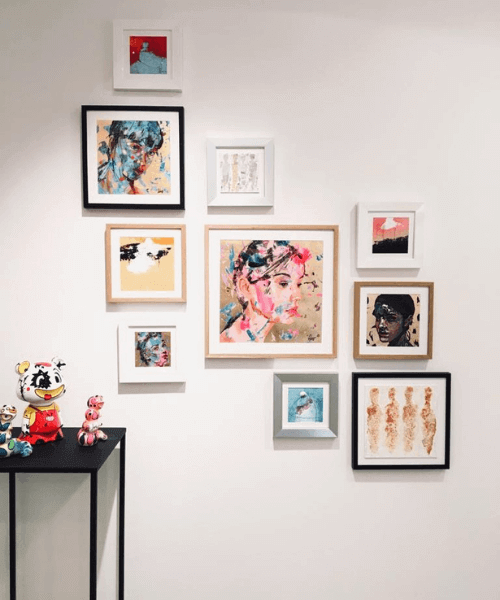The keys to understanding the art market
We have put together all the information you need to understand the art market in just a few minutes. What is the first and second on the art market?
Where to get a work of art and how to resell it? What taxation applies to the purchase and sale of works of art? We answer your questions in our special art market guide.
Summary
- Understanding the art market: the first art market
- Understanding the art market: the second art market
- Understanding the art market: the side of an artwork
- Understanding the art market to buy a work
- Understanding the art market: taxation of an artwork
- Understanding the art market: reselling an atwork
- To learn more about the art market, see our other pages:
Understanding the art market: the first art market
The first art market refers to the initial sale of an artwork.
Clearly, the first art market focuses on contemporary art (late twentieth and early twenty-first century). So here we are talking about the very first sales of an artwork executed by emerging artists. These transactions can take the form of direct sales between artists and collectors or sales organized by art dealers or art galleries representing one or more artists. The leading art market accounted for 56% of art sales worldwide in 2019. The United States held the first place in the world art market, followed by the United Kingdom and China.
Understanding the art market: the second art market
Once a work is purchased on the primary market, it enters the secondary art market.
Simply put, the secondary art market refers to works that have been sold at least once before. These works come from listed artists enjoying a solid reputation. Most of an artworks sold in auction houses are part of the secondary art market. The secondary art market includes all transactions after the first sale.
This includes all sales made by art galleries, private sales and auctions held by auction houses.


Understanding the art market: the side of an artwork
In the primary art market, the initial value of the artwork is set by the artist or the gallery. No particular standard makes it possible to establish the price of a work. However, some criteria can have an influence:
- the history of the artist's exhibitions;
- the artist's previous sales history;
- the artist's training and career level;
- demand from collectors;
- the market economy;
- the size of the object;
- the materials, the technique and the time required for the creation.
In the second art market, the price of an artwork is set according to criteria such as:
- reputation of the artist;
- prices obtained in previous auctions;
- exhibitions in prestigious places
- works honored by a museum or artistic institution;
- works owned by a famous collector;
- artist linked to a leading gallery;
- date of creation of the work
- rarity of the item.
Databases listing artists' ratings are available online.
Understanding the art market to buy an artwork
Artist's studio, international fairs or fairs, galleries or art dealers, auctions: where to buy an artwork? We take a detailed look at the various players that mark the art market in France and internationally.
Contemporary art galleries
The amount of sales made by galleries and art dealers around the world is estimated at $ 36.8 billion (approximately € 30.25 billion) for the year 2019. With e-commerce experiencing unprecedented growth, the online art market is also reaching new heights globally with a record $ 12.4 billion in 2020 (or around € 15 billion). During transactions, art galleries receive a sales commission.
The price of the works is generally fixed in consultation between the galleries and the artists.
Art dealers
Intermediaries between the artist and the buyer, art dealers are experts responsible for finding artworks or collectibles on behalf of their clients.
Their field of action is not limited to France: their research focuses on the national and international art market. Art dealers commonly collaborate with art galleries, museums and art institutions. Their remuneration takes the form of a commission (10 and 20% of the sale price).
Auction houses
In France and abroad, there are two types of auction:
- auctions arbitrated by an auction house
- online auction brokerage.
The auction houses take a commission on each sale (25% of the sale price at most).
Auctions totaled $ 24.2 billion in sales in 2019. Post-war and contemporary art represent a 53% market share.
The top 5 auction houses in the world are:
- Christie's (London - United Kingdom)
- Sotheby's (New York - United States)
- Phillips (London - United Kingdom)
- China Guardian (Beijing - China)
- Poly Auction (Hong Kong)
In France, the main auction houses are:
- Artcurial (Paris)
- Aguttes (Paris and Lyon)
- Millon (Paris and Lyon)
- Tajan (Paris).
International art fairs
Les foires d’art internationales réalisent un quart des ventes d'art dans le monde.
Ces salons où convergent galeries, marchands d'art, artistes et collectionneurs se déroulent chaque année en Europe, en Asie et en Amérique. Parmi les plus prestigieuses, nous pouvons citer :
International art fairs account for a quarter of art sales worldwide.
These fairs, where galleries, art dealers, artists and collectors converge, take place every year in Europe, Asia and America. Among the most prestigious, we can cite:
- Art Basel (Basel - Switzerland)
- The European Fine Art Fair or TEFAF (Maastricht - Netherlands)
- The Paris International Contemporary Art Fair or FIAC (Paris - France)
- Frieze London and the Frieze Masters (London - Great Britain)
- ARCO Madrid (Madrid - Spain)
- The Armory Show (New York - United States)
International art fairs and fairs have a turnover of 16.6 billion dollars (13.6 euros) for 2019.
16.png)



Understanding the art market:
In France, the taxation of an artwork of art varies depending on whether you are on the side of the buyer or the seller, an individual or a company.
The taxation of works of art for individuals
The purchase of works of art is subject to VAT. The rate applied is 20%, lowered to 5.5% for:
- works acquired in France
- imports of works of art (from the European Union or not)
- works acquired directly from the artist or his successors in title
No VAT is applicable if the purchase is made from a seller who is not subject to VAT. The taxation of works of art for resale differs depending on the date of acquisition. When selling works of art, the seller can choose between when selling works of art, the seller can choose between:
- a flat-rate tax equal to 6.5% of the sale price
- a capital gain tax at a rate of 36.2% with an allowance of 5% per year of detention and total exemption after twenty-two years of detention.
- for the benefit of museums or public institutions
- less than 5,000 euros
- carried out by a seller who does not have his tax domicile in France.
Taxation of artworks on the business side
Under certain conditions, a large number of companies can benefit from a tax deduction for the purchase of artworks.
To be eligible, works of art must be acquired from a living artist with or without an intermediary.
They must be exhibited in a place accessible to the public and / or to company employees for 5 years.
They can also be entrusted to a museum. In the case of musical instruments, they must be loaned free of charge to performers who request them.
Understanding the art market: reselling an artwork
- the sale by mutual agreement. It can be carried out with or without the intermediation of a professional (galleries, art dealers, etc.).
- Auction. It makes it possible to benefit from a reserve price below which the works cannot be auctioned. Sellers' fees of up to 20% of the hammer price or hammer price are to be expected.
- Depositing artworks with a gallery owner, a second-hand dealer or an antique dealer. A commission of 20% to 30% of the estimated price will be requested.
Complementary article
find out more :
Other articles:


